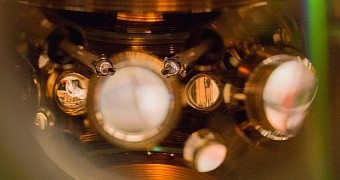Researchers with the National Institute of Standards and Technology claim to have perfected an atomic clock and to have made it so sensitive and precise that it will from now on fail to lose or gain be it 1 second for 15 billion years.
The strontium atomic clock in question, developed by National Institute of Standards and Technology researchers in collaboration with scientists at the University of Colorado Boulder, first made headlines last year, when it set a new world record for precision.
At that time, the atomic clock was so good at measuring time that its creators said it would not lose or gain 1 second in 5 billion years. Now that it's been perfected, the clock is three times more accurate.
Just to put things into perspective, scientists at the National Institute of Standards and Technology point out that the 15 billion years their strontium atomic clock will run with astounding precision is the equivalent of the age of the universe.
Why we need such precise clocks
Writing in the journal Nature Communications, researchers with the National Institute of Standards and Technology explain that precise clocks like the new record holder they developed are needed for technologies such as advanced communications and positioning techniques like GPS.
They can also reveal slight differences in the passage of time depending on altitude and gravity. These differences were predicted by Albert Einstein in his theory of relativity, which argued that clocks would tick at a more rapid pace at higher elevations.
“The clock is now good enough to measure tiny changes in the passage of time and the force of gravity at slightly different heights. Einstein predicted these effects in his theories of relativity, which mean, among other things, that clocks tick faster at higher elevations,” they wrote in a statement.
“Time can be intricately connected to gravity. It sounds like science fiction, but these measurements are a reality,” added physicist Yun Ye. Indeed, past studies have shown that clocks at sea level and those on a mountain top tick just a tad differently.
Because it can double as a gravity sensor, the new and improved record-setting strontium atomic clock can serve to make stunningly accurate three-dimensional measurements of the shape of our planet and help create a map revealing Earth's exact anatomy.
How the strontium clock works
Atomic clocks such as the one developed by the National Institute of Standards and Technology in collaboration with the University of Colorado Boulder work by keeping tabs on atoms jumping between specific energy levels and measuring their vibrational frequency.
In a way, this method of measuring time by recording the vibration frequency of an atom is not all that different to monitoring and documenting the orderly swings of an old-fashioned pendulum, researchers explain. Except for the fact that one is working with elementary particles.
Presently, one second, which is the base unit of time in the International System of Units, is defined as 9,192,631,770 oscillations of a cesium atom. In the case of the new clock, it’s the natural vibrations of strontium atoms that define a second and keep an accurate record of time elapsed.
The reason this new atomic clock is more precise than its predecessors is because atoms of strontium oscillate between energy levels at a rate of 430 trillion times per second. To induce this behavior, the atoms are exposed to red laser light.
Thanks to technological advances eliminating any potential interferences from the outside world, the National Institute of Standards and Technology's new strontium atomic clock can be operated at room temperature. Previously, it had to be kept in a cryogenic environment.

 14 DAY TRIAL //
14 DAY TRIAL //